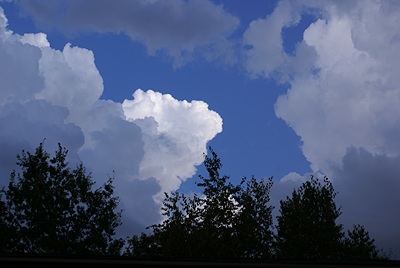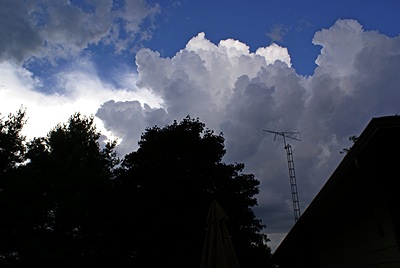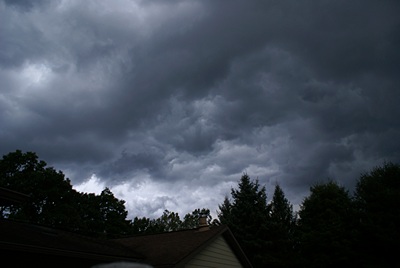We awoke to temperatures in the low 70’s this morning and by noon it was forecast to be 85 degrees F with rapidly rising humidity. We turned our A-C on yesterday and left in on overnight and through the day today.
WordPress 4.0 was released yesterday and just before midnight I updated the four websites I manage, including this one. I was looking forward to working with the new version today, but first things first. Darryll called at 8:15 AM to make sure it was OK to come over. We finished breakfast and then opened the garage and moved a few things that might be in his way. Although we would have liked to continue working in the garage during the morning, before it got really hot and humid, we were glad to have Darryll here working on the HVAC installation.
Instead of working on organizing the garage Linda worked at her desk and baked a loaf of bread while I assisted Darryll. He wired up the library thermostat and showed me how the wires were connected. He installed the return air grill, which required some minor drywall trimming, and installed a 6″ combustion air duct in the ceiling of the utility closet. The duct had a screen on one end with a hood, like a dryer vent, and was open on the other end. He installed it from the attic side with the hood in the attic and the open end sticking down through the ceiling into the closet. I may decide to caulk or apply drywall compound to fill that gap between the duct and the hole Darryll made in the ceiling.
Darryll’s main focus, however, was hooking up the four pieces of duct, two rigid and two flexible, that will carry conditioned air into the library and installing the two ceiling registers. That involved working in the attic which was very hot. The flexible duct for the two ceiling registers was the same kind of product that was used in the main house; a pre-insulated flexible accordion tubing with an 8″ inside diameter that comes in 25′ lengths compressed to about 3′ for shipping. To feed the two registers on the lower part of the west wall of the library he cut lengths of 8″ diameter (circular cross section) metal duct and assembled them. He attached them to the supply air duct (plenum) with flange connectors. He then slide insulation blankets (tubes) around them and connected the bottom ends of the duct into the back of the register ducts using several elbows to bring the duct around and close to the wall. Finally, he slid the insulation down and secured it.
While Darryll was doing all of that I finished connecting the AC power to the condenser/compressor. That involved the following:
- removing the terminal cover panel from the inside of the fused disconnect box
- knocking out access holes on the right side and bottom
- mounting the fused disconnect box to the side if the house
- cutting a piece of 3/4″ plastic conduit for the cable from the soffit to the box
- running the NM cable through the conduit
- installing a watertight 90 degree elbow into the conduit
- attaching the elbow to the side of the box
- cutting, stripping, and connecting the line wires
- cutting the plastic armor on the hookup cable to the right length
- installing a straight screw-in watertight connector on the box end of the armor
- installing a screw-in 90 degree elbow watertight connector on the condenser end
- cutting, stripping, and connecting the load wires in the box
- cutting, stripping, and connecting the load wires in the compressor.
I had Darryll check my work and then installed the fuses in the pull-out disconnect but was not able to get it to plug all the way in. Darryll bent the blades slightly and got it to seat fully. (I need to get two different fuses. All he had were 30A fuses but 20A would be sufficient. Also, the fuses he had in his truck were notched on one end. I think fuses with full barrels on both ends would be better as they would have more contact surface than the notched ones.) I reinstalled the terminal cover panel and closed the box. I then re-installed the cover panel on the A-C compressor that Darryll had removed earlier.
With the power connected and most of the ducts run, we turned on the 120VAC/15A circuit breaker (for the unit in the utility closet) and the 240VAC/20A circuit breaker (for the compressor/condenser). Darryll turned the thermostat mode switch to “cool” and the fan switch to auto and the A-C came to life. Hooray! I love it when that happens.
While Darryll finished installing the ducts and the registers I connected and mounted the thermostat for the garage furnace and then connected the wires on the other end of the cable to the terminals on the back of the unit according to Darryll’s instructions. I removed the end panel from the Reznor ceiling-mounted garage furnace, removed the documentation packet from the inside, checked that the gas valve was in the “on” position, and put the end panel back on. I also removed the protective plastic film from the bottom of the unit.
Darryll gathered up his tools, extra parts, and unused materials and loaded them in his truck. He then pressurized his portable air compressor and used it to pressurize the black iron gas pipe. It has not been holding pressure, so he pumped it up to 15 PSI and we went in search of leaks with a spray bottle of soapy water. We used my inspection mirror to see behind and under connections and found three leaks. One was in a 2″ pipe fitting behind the garage, one was in a 2″ pipe fitting near the end of the run by the generator, and one was at an elbow in the 1/2″ pipe where it exits the utility closet on its way to the garage furnace.
Darryll was checking air temperature readings at the registers and in the main plenum of the library HVAC unit. The library was 89 degrees F when he first turned the A-C on, and the attic was a lot hotter than that. He connected his gauges to the compressor/condenser and said the readings were close enough to correct that he did not want to add or remove any refrigerant until the room had cooled down and stabilized at the requested temperature.
I was hoping he would get the job finished today but he needed some equipment, which he did not have with him, to work on the iron pipe and he was obviously tired from a long day working in the high heat and humidity. He may be back tomorrow; if not, Monday or Tuesday. Whenever he returns, I have complete confidence that he will get it done before the gas meter is hung and that it will all work correctly for many years with very little attention other than changing a filter once or twice a year.
We deferred lunch until Darryll left. We had chickpea salad on a slice of the bread Linda had baked earlier, corn-on-the-cob, and the last of some fresh pineapple. Nothing says “summer” like organic, non-GMO corn-on-the-cob.
After lunch I called Bratcher Electric to check on the status of the estimate/quote that Mike was putting together to service our generator, convert it to natural gas, and run a 100A Service Entrance Cable from the transfer switch to the garage panel, converting it from a sub-panel to a main panel. Karen said they have been really busy but he would work on it over the weekend.
I also called 1-800-Pack-Rat to arrange pickup of the storage container on Friday September 12th. Steven was not able to schedule the pick-up during the call and said he would contact the local office and get back to me. I made it clear that we did not want to roll over into another billing cycle and I was calling one week ahead of time as we had been instructed. He assured me that it would not be a problem. About an hour later we got a return call and follow up e-mail confirming pickup for Friday, September 12.
Late afternoon I checked on the library A-C to make sure it was not freezing up. Everything looked OK. The thermostat was set to 76 degrees F and the temperature was down to 77, so I bumped the setting up to 78 to let it cycle off and on. Although Darryll did all of the heavy lifting on this project (literally) I spent my fair share of time in the attic on warm days installing the pull-down folding ladder and working on electrical wiring and attic lights. It was very gratifying to see that all of this work—his, mine, and Linda’s—finally result in something that operated correctly.
We were relaxing and reading when severe weather watches and warnings for our area started arriving on our iPads. Naturally we went outside to see what was going on. We were both born and raised in the Midwest, the St. Louis, Missouri area, to be exact, and as kids in the 1950’s, threatening weather was a form of summertime entertainment. Not that we were stupid; we learned from the adults around us when the show was over and it was time to head to the basement. When I was about 5 years old we lost a plum tree in our backyard to a close encounter with a tornado.
The clouds were very dramatic but eventually gave way to a formless mass of gray with swirling winds and a few raindrops. We checked the Weather Channel app and the Weather Underground Wundermap app on our iPads. The radar returns showed that we were likely in for some rain, and we got some, but as often happens the worst of it passed north and south of us. The rain we did get was very welcomed. We had heavy rain on Monday (Labor Day), Keith mowed the grass on Tuesday, I spread grass seed around on Tuesday and Wednesday, and a flock of six wild turkeys feasted on the grass seed on Wednesday and Thursday. We needed a nice light rain to help the seeds germinate and take root rather than be eaten or washed away in a thunderstorm.
Around 7:30 PM our power flickered several times and we received e-mail messages from our generator letting us know that utility power had been lost and then quickly regained. We decided to check the Kohler OnCue software to see what the generator was doing. We thought sure we had installed the software on Linda’s computer, so we could monitor it from her desk in the kitchen/dining area, but it wasn’t there. After much searching and head scratching we checked my old laptop and there it was! When we thought about it we realized that the generator had been installed about a week before Linda started configuring her new Samsung laptop, so there was no way we had put the software on her machine. We’ve been very, very busy the last 20 months, so it was not surprising to us that we had forgotten the exact sequence of events.
The severe warnings expired at 8 PM and the severe watches at 9 PM, but that did not mean the rain was done. A big fetch of moisture was located south of Chicago, Illinois and moving through southwest Michigan in our general direction. The rain was forecast to continue into the early hours of tomorrow but be done before sunrise. When the rains finally came it rained hard for a while. Tomorrow is forecast to be a perfect Michigan day and I plan to buy another bag of grass seed to spot seed the areas that got washed away, again.


